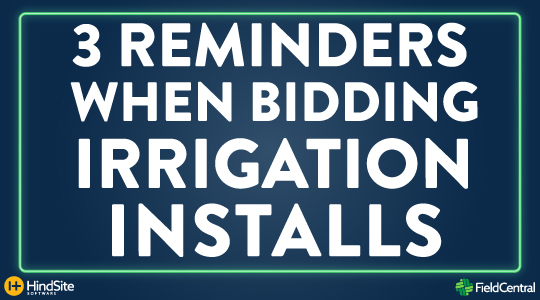
You are a professional irrigation contractor. That means you know much more about putting pipe, valves, risers, and rotors in the ground than we do (and if not, talk to IrriTech Training). But we’ll bet that we talk to more of your peers than we do… and in doing so, here are a few quick reminders that irrigation pros like yourself might be forgetting when you’re bidding a job.
It’s all about The Margin.
We get it, you hear this all the time. Margin margin margin. Yadda yadda yadda. But there’s a reason it’s always talked about. You MUST price your jobs based on the margin you need to be successful. It’s not about the “top line,” or the total bid. It’s about the “bottom line,” how much profit you’ll make after the job is done.
And the margin isn’t just your materials and labor (though that’s obviously the biggest chunk). You have to include your overhead. The lights in the office don’t keep themselves on… you do. So take a minute to figure out how much all the non-job stuff costs. Your electricity, phone, internet, office and shop supplies, rent, marketing, taxes, etc. Quantify that, and use it to set your margin per job. Know what you want to have (“boy, I’d love 50% on every deal!”), and what you have to have (“If I’m under 15%, I’m losing money.”).
Don’t price every job the same.
You serve more than one market. Maybe it’s the McMansions and the townhomes, the school and the bank, or the metro and the ‘burbs… whatever it is, you should NOT price these the same. It’s not about who has more money, it’s about the level of service and value that you can provide.
Each of those markets has its own unique expectations and needs. By meeting those needs, you create value, and at the end of the day, you’re selling value, not irrigation systems.
For example, upper-class digs have higher expectations. They want more discussion with you about the design, have more advanced systems (which means more training, or the opportunity for maintenance and “white glove” treatment), and perhaps be more particular about the state of the property. By accommodating all of those things, you are providing the value and experience they expect… and that’s worth something.
It’s not a bid, it’s a “Proposal”
This one is small but important. A bid implies a low price offer, and - as we talked about above - you’re setting key margins and selling value. An estimate implies uncertainty (“well, I think it’ll be this much…”). A proposal educates the client, provides details about what you’ll do and how you’ll do it, and includes the price. How much you negotiate from there is up to you, but start out strong. Present yourself like the professional you are.
For more resources about estimating your next job, check out our Sales & Estimating Guide.








